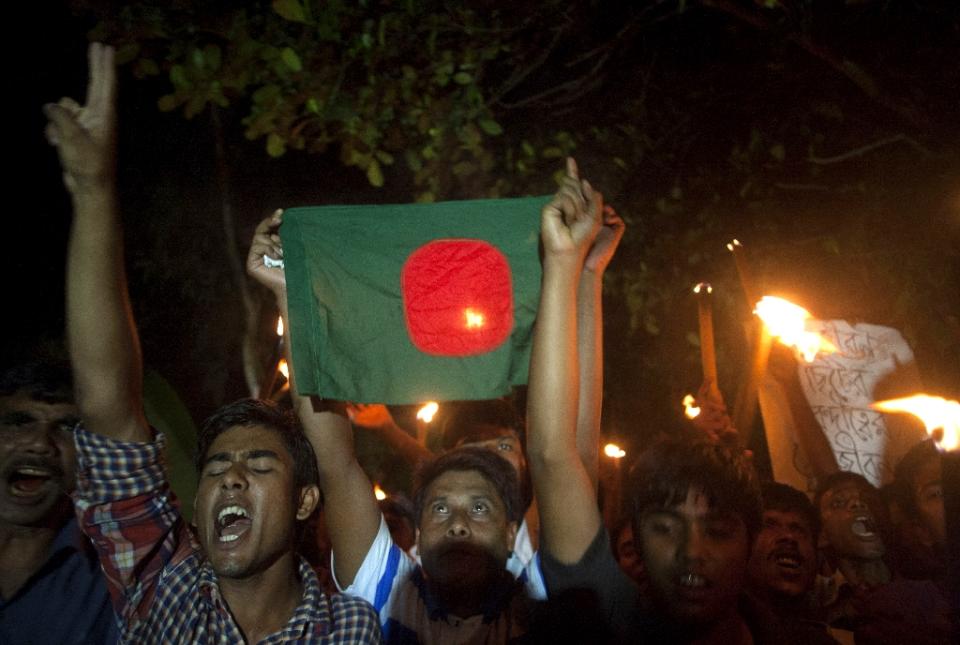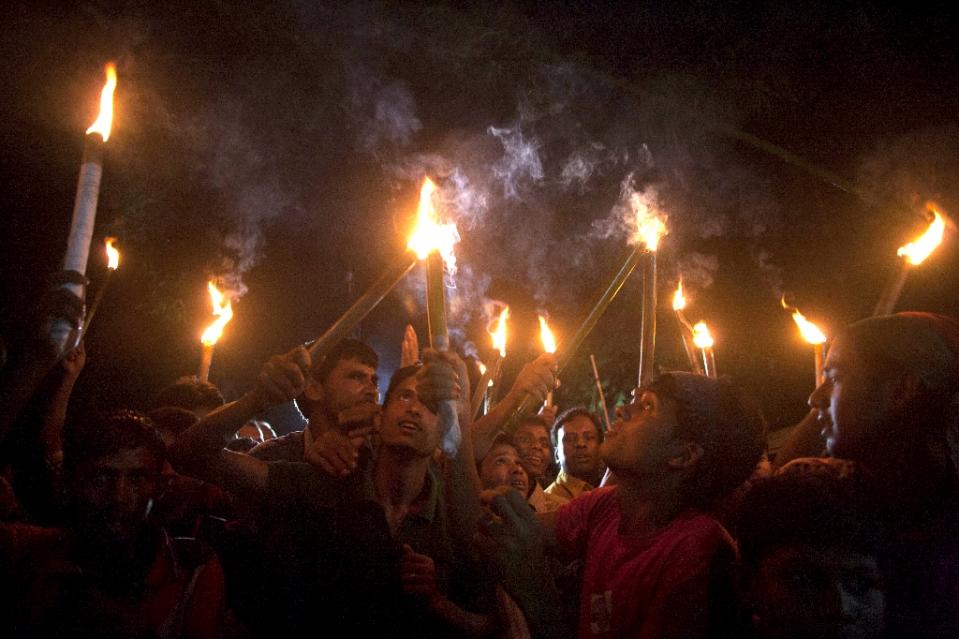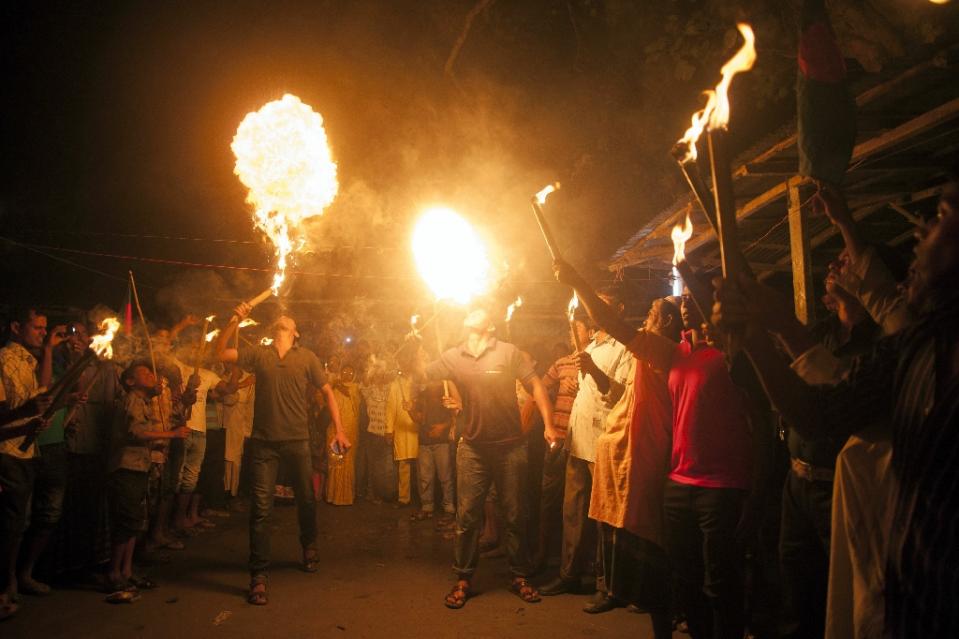
As the clock struck one minute past midnight (1801 GMT Friday), thousands of people who have been living without schools, clinics or power for a generation erupted in cheers of celebration for their new citizenship.
"We have been in the dark for 68 years," said Russel Khandaker, 20, as he danced with friends in the Dashiar Chhara enclave, which belonged to India but has now became part of Bangladesh.
"We've finally seen the light," he told AFP.
A total of 162 islands of land -- 111 in Bangladesh and 51 in India -- were officially handed over to the countries surrounding them on Saturday after Dhaka and New Delhi struck a border agreement in June.
The land-swap means some 50,000 people who have been living in the isolated enclaves since 1947 will now become part of the countries that surround their homes.
In Dashiar Chhara, thousands of people defied monsoon rains to celebrate, marching through rain-soaked muddy roads singing the Bangladeshi national anthem and shouting: "My country, your country. Bangladesh! Bangladesh!"
Others lit 68 candles to mark the end of "68 years of endless pain and indignity".
Sharifa Akter, 20, held a candle in her hand and smiled. "I can now fulfil my dream of being a top government bureaucrat," she told AFP.

Officials from Bangladesh and India hoisted their respective national flags over their new territories on Saturday morning in formal ceremonies.
"We sang the national anthem as we raised the Bangladesh flags at 6:00 am (0000 GMT) in all 111 enclaves that are now part of Bangladesh territory," said Shafiqul Islam, chief government administrator in northern district of Debiganj.
Islam said the Bangladesh government would now roll out a "fast-track master plan" to develop the enclaves. The plan includes building new roads, schools, power lines and clinics.
India has added more than 15,000 new citizens to its population, while over 36,000 enclave residents took Bangladeshi nationality under the historic agreement.
In West Bengal state's Mashaldanga enclave, the main site for celebrations on the Indian side, residents have for decades lived as Bangladeshis in the foreign land.
Having opted for Indian citizenship under the deal, they rallied with torches, let off fire crackers and hoisted the Indian flag to celebrate their "freedom".
"We have waited so long for this moment," said a jubilant resident, Tapas Das.

Comment:
Modi's Bangladesh Border Breakthrough Bodes Well
...
India and Bangladesh have a 4,100-km (2,500-mile) border drawn erratically in heavily populated areas that left the enclaves invisible on most maps and on the ground. Some 50,000 inhabitants have effectively been stateless in 111 Indian enclaves situated in Bangladesh and 51 Bangladeshi enclaves in India.
The Economist reported that there was even "the world's only 'counter-counter-enclave'—a patch of India surrounded by Bangladeshi territory, inside an Indian enclave within Bangladesh." One theory about the history is that the enclaves "resulted from a series of chess games played between two maharajas centuries ago," while another suggests that they were born of "18th-century treaties signed between local rulers and the Mughal empire, before the emergence of the British raj."
...
A bilateral deal was also almost done by the previous prime minister, Manmohan Singh, when he made a prime ministerial visit to Dhaka in 2011, but he failed because Mamata Banerjee, the unpredictable irascible chief minister of West Bengal, refused to go along on the visit and approve the deal.
That may have been partly pique that she had not been properly consulted in advance, but she was also worried about political repercussions in the north of her state that could lose some water.
Modi's breakthrough on the enclaves was partly the result of liaison with Banerjee that led to financial grants for her state and to her being in Dhaka at the same time as his visit. Modi was also able to persuade the Bangladeshis that Delhi would deliver on its promises, which meant overcoming historic distrust of India's often overbearing diplomacy.
"Thousands of people will get new identities. Congratulations to them," Banerjee said on Twitter.
Local ruling politician Rabi Ghosh said his government's priority is to reach out to his new compatriots and to see their children go to schools and sick get treated at hospitals.
"By December we will ensure all villages are connected with roads, electricity and drinking water," Ghosh told AFP.
'Oh what a joy!'
The enclaves date back to ownership arrangements made centuries ago between local princes.
The parcels of land survived partition of the subcontinent in 1947 after British rule, and Bangladesh's 1971 war of independence with Pakistan.
Bangladesh endorsed a deal with India in 1974 in a bid to dissolve the pockets, but India only signed a final agreement in June when Prime Minister Narendra Modi visited Dhaka.
In the final hours before the handover, villagers held special feasts and joined prayers in mosques and Hindu temples to usher in the new era.
Prodeep Kumar Barman sang a devotional song praising Hindu Lord Krishna as he led his troupe near a temple at the main bazaar in Dashiar Chhara, singing: "Oh what a joy, what a joy!"
Plans for more lavish festivities have been scaled back as India is observing a period of national mourning for former president A. P. J. Abdul Kalam, who died this week.
"This is the biggest celebration of my life. I can't describe how I feel today," said Parul Khatun, 35, a resident of the Indian enclave of Kot Bajni.
Both India and Bangladesh conducted surveys this month asking enclave residents to choose a nation.
The overwhelming majority of people living in Indian enclaves in Bangladesh opted for Bangladeshi citizenship, but nearly 1,000 people on the Bangladesh side opted to keep their Indian nationalities.
They now have to leave their homes by November for India where they will be resettled in the state of West Bengal.
The decision has split some families along generational lines, with ambitious young people moving to India and leaving behind parents who are either afraid to move or just want to stay where they grew up.
Source: AFP



Comment: This is part of Modi's strategy to reduce the terrorist insurgencies that have plagued the north-eastern part of India for many decades.